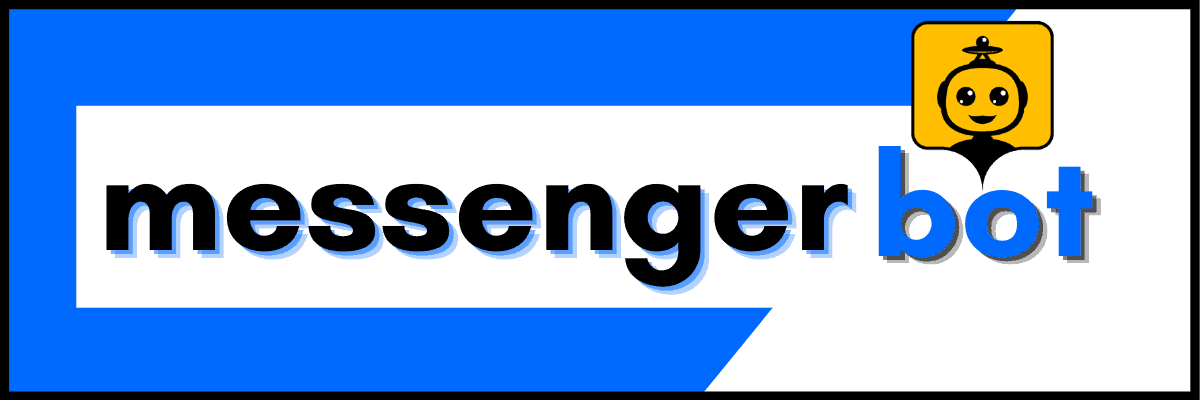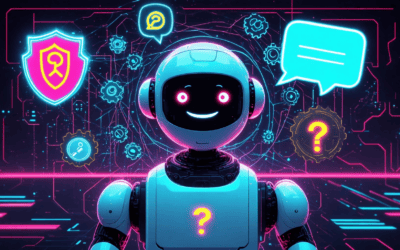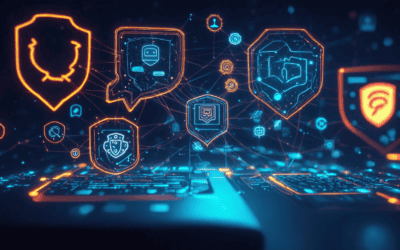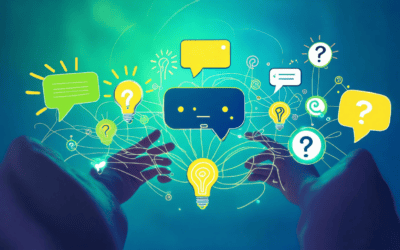In today’s fast-paced digital landscape, virtual bots are revolutionizing the way businesses interact with their customers. These sophisticated virtual agents serve as the frontline of customer service, providing instant responses and support that enhance user experience. But what exactly is a virtual bot? In this article, we will delve into the definition and evolution of virtual bots, explore the legal considerations surrounding their use, and evaluate whether there are effective free AI bot options available. Additionally, we will analyze the performance of ChatGPT among other chatbot agents and discuss the broader purpose of bots in modern business. By understanding the role of virtual chatbots and their impact on customer interactions, you will gain valuable insights into how these technologies can be leveraged for success. Join us as we uncover the transformative power of chatbots vs virtual assistants and the benefits of implementing virtual agent software in your organization.
What is a virtual bot?
A virtual bot, also known as a virtual agent or chatbot, is an advanced conversational software application that utilizes artificial intelligence (AI) and natural language processing (NLP) to interact with users in a human-like manner. These bots are designed to understand, interpret, and respond to customer inquiries across various platforms, including websites, messaging apps, and social media.
Understanding the Definition of Virtual Bots
Virtual bots serve as digital assistants that enhance customer interactions by providing immediate responses and assistance. Key features of virtual bots include:
- Natural Language Understanding (NLU): Virtual bots leverage NLU to comprehend user intent and context, allowing for more accurate and relevant responses. This technology enables them to process and analyze human language effectively.
- 24/7 Availability: Unlike human agents, virtual bots can operate around the clock, providing immediate assistance to customers at any time, which enhances user experience and satisfaction.
- Scalability: Virtual bots can handle multiple interactions simultaneously, making them an efficient solution for businesses experiencing high volumes of customer inquiries.
- Cost-Effectiveness: Implementing virtual bots can significantly reduce operational costs by minimizing the need for extensive customer service teams, while still maintaining high levels of service.
- Data Collection and Analysis: These bots can gather valuable data from customer interactions, which can be analyzed to improve services, understand customer preferences, and refine marketing strategies.
- Integration Capabilities: Virtual bots can be integrated with various systems, such as CRM platforms and databases, to provide personalized responses and streamline workflows.
Recent studies indicate that businesses utilizing virtual bots have seen a 30% increase in customer engagement and a 25% reduction in response times (source: Gartner, 2023). Furthermore, as AI technology continues to evolve, the capabilities of virtual bots are expected to expand, making them even more effective in enhancing customer service experiences (source: McKinsey & Company, 2023).
The Evolution of Virtual Bots in Customer Service
The evolution of virtual bots in customer service has been remarkable, transitioning from simple automated responses to sophisticated virtual agents capable of engaging in complex conversations. Initially, virtual bots were limited to basic question-and-answer formats, but advancements in AI and NLP have enabled them to understand context and sentiment, making interactions more human-like.
Today, virtual bots are integral to customer service strategies across various industries. They not only assist in answering queries but also play a crucial role in lead generation and customer retention. For instance, platforms like Brain Pod AI offer innovative solutions that enhance the capabilities of virtual bots, allowing businesses to provide personalized experiences that resonate with customers.
As we look to the future, the role of virtual bots will continue to expand, with ongoing improvements in AI technology paving the way for even more advanced functionalities. This evolution signifies a shift towards more efficient, responsive, and customer-centric service models, ultimately transforming how businesses interact with their clients.

Are Online Bots Illegal?
The legality of online bots varies significantly depending on their purpose and the jurisdiction in which they operate. Here are key points to consider:
- Fraudulent Activities: Many countries have implemented laws targeting bots that engage in deceptive practices. For example, the United States has the Better Online Ticket Sales (BOTS) Act, which specifically prohibits the use of bots to bypass security measures on ticket-selling platforms. This law aims to protect consumers from unfair practices in the ticketing industry.
- Data Scraping: Bots that scrape data from websites without permission can also face legal challenges. The Computer Fraud and Abuse Act (CFAA) in the U.S. has been used to prosecute individuals and companies that unlawfully access computer systems, including through automated means.
- Regulatory Frameworks: In the European Union, the General Data Protection Regulation (GDPR) imposes strict rules on data collection and processing, which can affect how bots operate, especially those that collect personal data. Non-compliance can lead to significant fines.
- Ethical Considerations: Beyond legality, the ethical implications of using bots should be considered. Bots that manipulate online interactions or mislead users can damage trust and lead to reputational harm for businesses.
- Legitimate Uses: Not all bots are illegal. Many bots serve beneficial purposes, such as customer service chatbots, automated monitoring tools, and data analysis applications. These bots typically operate within legal boundaries and adhere to relevant regulations.
In conclusion, while certain types of bots may be illegal, particularly those involved in fraudulent activities or unauthorized data collection, many bots operate legally and ethically. It is crucial for developers and businesses to understand the legal landscape and ensure compliance with applicable laws and regulations.
Legal Considerations Surrounding Virtual Bots
Understanding the legal implications surrounding virtual bots is essential for businesses utilizing these technologies. The primary focus should be on compliance with existing laws and regulations that govern their use. For instance, virtual agents that function as customer service chatbots must adhere to data protection laws, ensuring that user data is handled responsibly. Additionally, businesses should be aware of the potential for legal repercussions if their bots engage in activities deemed illegal, such as data scraping or fraudulent transactions.
Compliance and Regulations for Virtual Agents
Compliance is a critical aspect of deploying virtual agents. Companies must ensure that their virtual bots comply with regulations like GDPR in Europe, which mandates transparency in data collection and user consent. Furthermore, organizations should regularly review their practices to align with evolving legal standards, thereby minimizing risks associated with non-compliance. By prioritizing compliance, businesses can leverage the benefits of virtual agents while maintaining trust and integrity in their operations.
Is There a Free AI Bot?
When exploring the landscape of virtual bots, many businesses often wonder if there are effective free options available. The good news is that several platforms offer free AI bots that can significantly enhance customer engagement without straining your budget. These virtual agents are designed to automate interactions, streamline communication, and improve overall customer satisfaction.
Exploring Free AI Bot Options
There are numerous free AI bot options that cater to various business needs. Here are some notable mentions:
- ProProfs Chat: This user-friendly AI chatbot is perfect for startups and small to medium-sized businesses (SMBs). It offers seamless integration with your website, providing 24/7 customer support in multiple languages, which enhances customer engagement and satisfaction. [Source: ProProfs]
- Tidio: Tidio features a free plan that includes a chatbot, enabling businesses to automate responses and engage with customers in real-time. Its intuitive interface and integration capabilities make it a popular choice for small businesses. [Source: Tidio]
- Chatbot.com: This platform allows users to create AI chatbots without any coding skills through its free tier. It is particularly useful for lead generation and customer support, making it a versatile tool for businesses. [Source: Chatbot.com]
- ManyChat: Focusing on Facebook Messenger bots, ManyChat offers a free version that allows businesses to automate marketing and customer service interactions. Its drag-and-drop interface simplifies the bot creation process. [Source: ManyChat]
- MobileMonkey: This platform provides a free chatbot solution that integrates with Facebook Messenger and web chat, designed for marketing automation to help businesses engage effectively with their audience. [Source: MobileMonkey]
- Landbot: Landbot’s free plan allows users to create conversational chatbots for websites without coding. It emphasizes user experience with a visual builder, suitable for lead generation and customer support. [Source: Landbot]
- Flow XO: Offering a free tier, Flow XO includes chatbot creation for various platforms, including Facebook Messenger and Slack, with a range of templates and integrations to streamline customer interactions. [Source: Flow XO]
- Botpress: An open-source chatbot framework, Botpress is free to use and allows developers to create highly customizable chatbots, ideal for businesses with specific needs. [Source: Botpress]
- Dialogflow: Google’s Dialogflow offers a free tier for building conversational interfaces, supporting natural language processing for businesses looking to create intelligent chatbots. [Source: Google Cloud]
- Chatfuel: This platform provides a free plan for creating chatbots on Facebook Messenger, allowing businesses to automate responses and engage with users effectively. [Source: Chatfuel]
These options highlight the versatility and accessibility of virtual bots for businesses of all sizes, allowing for enhanced customer interaction without the need for significant investment.
Comparing Free AI Bots with Paid Alternatives
While free AI bots offer valuable functionalities, it’s essential to consider how they stack up against paid alternatives. Free options often come with limitations in terms of features, support, and scalability. For instance, platforms like Brain Pod AI provide advanced capabilities and customization options that can be crucial for larger businesses or those with specific needs. Paid solutions typically offer:
- Enhanced features such as advanced analytics and reporting tools.
- Greater customization options to tailor the bot experience to specific business requirements.
- Priority customer support and dedicated resources for troubleshooting.
- Scalability to handle increased user interactions as the business grows.
Ultimately, the choice between free and paid AI bots depends on your business’s unique needs and growth trajectory. For businesses just starting, free options can be a great way to test the waters, while established companies may benefit from investing in more robust solutions.
Is ChatGPT still the best AI?
When it comes to evaluating the performance of AI models like ChatGPT, Bing AI, and Google Bard, several metrics come into play, including accuracy, user experience, and adaptability. ChatGPT currently stands out in the landscape of virtual bots and virtual agents due to its impressive capabilities.
Analyzing ChatGPT’s Performance Among Virtual Agents
Recent evaluations show that ChatGPT achieves an impressive accuracy rate of approximately 81.5% (OpenAI, 2023). This high level of performance is attributed to its extensive training on diverse datasets and its ability to understand context effectively. Users report a more conversational and engaging interaction with ChatGPT, making it suitable for a wide range of applications, from casual inquiries to complex problem-solving.
In comparison, Bing AI follows closely with a success rate of around 77.8% (Microsoft Research, 2023). While it may not lead in accuracy, its integration with Microsoft products enhances its usability and accessibility. On the other hand, Google Bard reports an accuracy of about 63% (Google AI, 2023). Although still in development, it shows promise in generating creative content and understanding complex queries.
In conclusion, while ChatGPT currently stands out as the best AI in terms of accuracy and user experience, both Bing AI and Google Bard are evolving rapidly, each with unique strengths that cater to different user needs. Continuous advancements in AI technology will likely shift these standings, making it crucial for users to stay informed about the latest developments in the field.
Alternatives to ChatGPT in the AI Landscape
While ChatGPT is a leading choice among virtual bots, there are several alternatives worth considering. For instance, Brain Pod AI offers a robust AI chatbot solution that focuses on enhancing user engagement through multilingual support and advanced analytics. This makes it a strong contender in the realm of chatbots and virtual assistants.
Additionally, platforms like Brain Pod AI’s image generation and AI writer tools provide unique functionalities that can complement the capabilities of traditional chatbot agents. As businesses continue to explore the potential of virtual assistant chatbots, it’s essential to evaluate these alternatives based on specific needs and objectives.

What is the point of a bot?
A bot, short for “robot,” is a software application designed to automate tasks and simulate human behavior on the internet. The purpose of virtual bots in modern business is multifaceted, focusing on enhancing efficiency, improving customer interactions, and streamlining operations. Here are some key points about the purpose and functionality of bots:
- Automation of Repetitive Tasks: Bots are primarily used to automate repetitive tasks such as data entry, web scraping, and customer service inquiries. This automation increases efficiency and allows human workers to focus on more complex tasks.
- 24/7 Availability: Unlike humans, bots can operate continuously without breaks, making them ideal for tasks that require constant monitoring or interaction, such as managing social media accounts or providing real-time customer support.
- Data Processing and Analysis: Bots can quickly process large volumes of data, making them valuable for analytics, market research, and trend analysis. They can gather information from various sources and present it in a digestible format.
- Enhanced User Interaction: Many bots, particularly chatbot agents, are designed to interact with users in a conversational manner. They can answer questions, provide recommendations, and assist with transactions, enhancing the overall user experience.
- Scalability: Bots can easily scale operations to handle increased workloads without the need for additional human resources. This scalability is particularly beneficial for businesses experiencing growth or seasonal fluctuations.
- Cost Efficiency: By automating tasks that would otherwise require human labor, bots can significantly reduce operational costs for businesses. This cost efficiency can lead to higher profit margins and better resource allocation.
- Integration with AI: Many modern bots incorporate artificial intelligence (AI) and machine learning, allowing them to learn from interactions and improve their performance over time. This integration enhances their ability to understand context and provide more accurate responses.
For further reading on the functionality and applications of bots, refer to sources such as Understanding Bots: The Future of Automation by the MIT Technology Review and The Role of Bots in Digital Transformation published by McKinsey & Company.
The Purpose of Virtual Bots in Modern Business
Virtual bots play a crucial role in modern business by enhancing operational efficiency and improving customer engagement. They serve as virtual agents that can handle a variety of tasks, from answering customer inquiries to processing orders. By leveraging virtual agent software, businesses can ensure that they are available to their customers at all times, providing immediate responses and support.
For instance, a chatbot virtual assistant can manage customer queries on social media platforms, allowing businesses to maintain a strong online presence without the need for constant human oversight. This not only improves customer satisfaction but also frees up human resources for more strategic initiatives.
Enhancing Customer Interactions with Chatbot Agents
Chatbot agents are designed to enhance customer interactions by providing personalized experiences. These virtual bots can analyze user data and preferences, allowing them to tailor responses and recommendations effectively. This level of personalization is essential in today’s competitive market, where customers expect quick and relevant interactions.
Moreover, the integration of multilingual capabilities in virtual chatbots enables businesses to reach a broader audience, breaking down language barriers and fostering global engagement. By utilizing tools like Brain Pod AI’s multilingual AI chat assistant, companies can ensure that they cater to diverse customer bases, enhancing overall user experience.
In conclusion, the point of a bot extends beyond mere automation; it encompasses a strategic approach to improving customer interactions and operational efficiency, making them indispensable in the modern business landscape.
What is the purpose of bots on the Internet?
Bots, short for robots, are automated applications designed to perform specific tasks on the Internet. They operate independently, executing pre-defined instructions without human intervention. The primary purposes of bots include:
- Automation of Repetitive Tasks: Bots excel at handling repetitive tasks such as data entry, web scraping, and monitoring online activities, significantly increasing efficiency compared to human efforts.
- Information Retrieval: Many bots are programmed to gather and analyze vast amounts of data from various sources, providing users with timely information. For instance, search engine bots index web pages to improve search results.
- Customer Support: Chatbots serve as virtual assistants, providing instant responses to customer inquiries, thereby enhancing user experience and reducing the workload on human support teams. According to a study by Gartner, by 2025, 75% of customer service interactions will be powered by AI and bots (Gartner, 2021).
- Social Media Management: Bots are used to automate posts, engage with users, and analyze social media trends, helping businesses maintain an active online presence.
- Cybersecurity: Security bots monitor network traffic for suspicious activities, helping to identify and mitigate potential threats in real-time.
- Gaming and Entertainment: In the gaming industry, bots can simulate player behavior, enhance user experience, and provide challenges in multiplayer environments.
- Market Analysis: Bots can track market trends and competitor activities, providing businesses with valuable insights for strategic decision-making.
In summary, bots play a crucial role in enhancing efficiency, improving user engagement, and providing valuable insights across various sectors of the Internet. Their ability to operate autonomously and handle large volumes of data makes them indispensable tools in today’s digital landscape. For further reading on the impact of bots, refer to the report by McKinsey & Company on automation in business (McKinsey, 2020).
The Role of Virtual Chatbots in Online Engagement
Virtual chatbots are essential in fostering online engagement, acting as the first point of contact for users seeking information or assistance. By utilizing advanced virtual agent software, businesses can create interactive experiences that cater to user needs. These chatbot agents can handle inquiries 24/7, ensuring that customers receive timely responses regardless of the time of day. This constant availability not only enhances user satisfaction but also builds trust in the brand.
Moreover, virtual bots can be programmed to learn from interactions, allowing them to improve over time and provide more personalized responses. This adaptability is crucial in today’s fast-paced digital environment, where user expectations are continually evolving. By integrating virtual assistant chatbots into their customer service strategy, businesses can significantly enhance their online engagement and drive higher conversion rates.
Virtual Agent Software and Its Impact on User Experience
The implementation of virtual agent software has transformed user experience across various platforms. These virtual bots streamline interactions by providing users with quick access to information, reducing the need for lengthy searches or waiting times. As a result, customers are more likely to engage with brands that offer efficient and effective support through chatbots and virtual assistants.
Additionally, the ability of virtual chatbots to handle multiple inquiries simultaneously allows businesses to manage high volumes of customer interactions without compromising quality. This scalability is particularly beneficial during peak times, such as holiday seasons or product launches, where customer demand surges. By leveraging virtual assistant bots, companies can ensure that they meet customer expectations while maintaining operational efficiency.
ServiceNow Virtual Agent examples
ServiceNow Virtual Agents are transforming the way organizations interact with their customers and employees through intelligent automation. These virtual bots are designed to streamline processes, enhance user experiences, and provide instant support across various platforms. By leveraging AI technology, ServiceNow chatbots can handle a wide range of inquiries, making them invaluable in today’s fast-paced digital landscape.
Real-World Applications of ServiceNow Chatbots
One of the most compelling aspects of ServiceNow Virtual Agents is their versatility in real-world applications. For instance, many organizations utilize these chatbot agents to manage IT service requests, allowing users to report issues, request services, and track the status of their inquiries without human intervention. This not only speeds up response times but also frees up IT staff to focus on more complex tasks.
Additionally, ServiceNow chatbots are employed in HR departments to assist employees with common queries related to benefits, payroll, and onboarding processes. By providing immediate answers through virtual assistant chatbots, companies can enhance employee satisfaction and reduce the workload on HR teams. The integration of Brain Pod AI can further enhance these capabilities, offering advanced features like multilingual support and AI-driven insights.
Benefits of Implementing ServiceNow Virtual Agents in Organizations
Implementing ServiceNow Virtual Agents offers numerous benefits for organizations. Firstly, these virtual agents significantly improve operational efficiency by automating routine tasks and inquiries. This leads to faster resolution times and a more streamlined workflow. Moreover, the ability to provide 24/7 support ensures that users can access assistance whenever they need it, enhancing overall customer satisfaction.
Another advantage is the cost-effectiveness of deploying virtual bots. By reducing the need for extensive human resources to handle repetitive inquiries, organizations can allocate their budgets more effectively. Furthermore, the analytics capabilities of ServiceNow chatbots allow businesses to gather valuable data on user interactions, enabling continuous improvement of services and support strategies. For more insights on how AI chatbots can revolutionize customer service, check out our article on AI-powered customer service bots.




